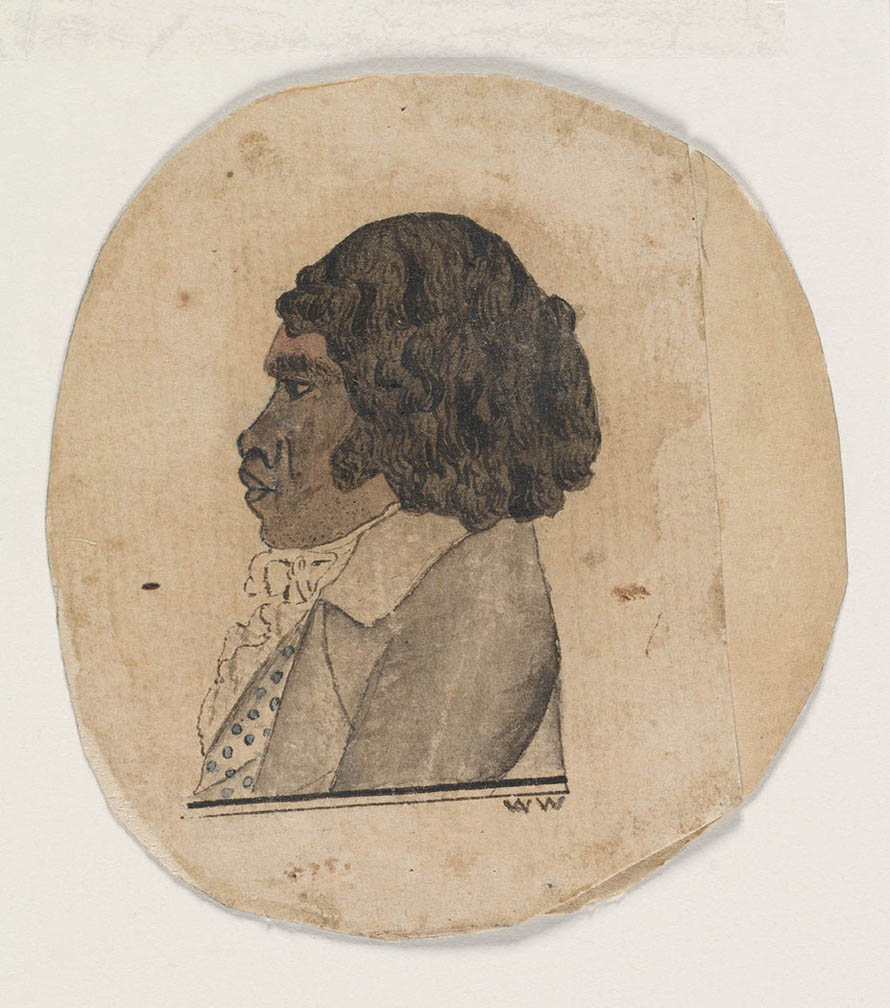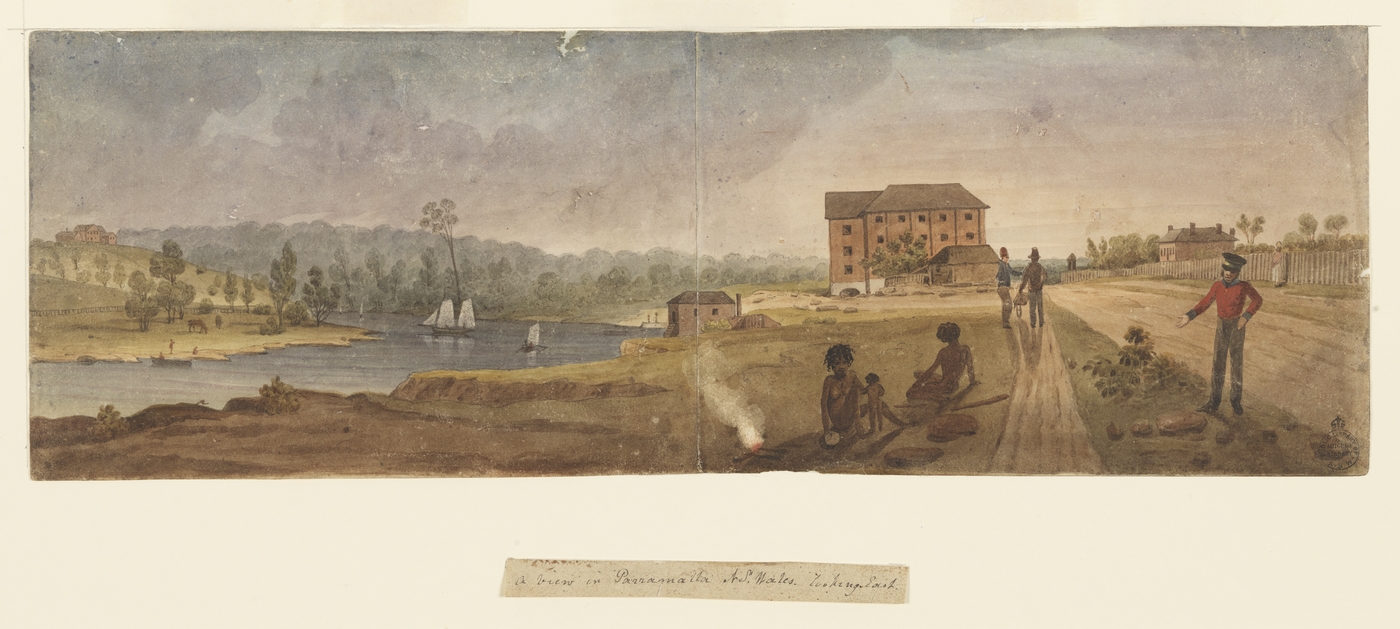The Dictionary of Sydney was archived in 2021.
Carangarang
Citation
Persistent URL for this entry
To cite this entry in text
To cite this entry in a Wikipedia footnote citation
To cite this entry as a Wikipedia External link
Carangarang
Born about 1771 into the Wangal clan on the south shore of the Parramatta River, Carangarang outlived her famous brother Woollarawarre Bennelong by 25 years. Carangarang was the best known of Bennelong's siblings and it is assumed that First Fleet authors refer [media]to her when they speak of 'Bennelong's sister'. Although not as well-known as her brother, Carangarang was a notable figure around Sydney and Kissing Point until the late 1830s, when she was in her sixties.
First accounts
The first record of Carangarang was in Daniel Southwell's vocabulary 'Words used by the Natives of New Holland, in the District of Port Jackson, New South Wales', which he sent to his uncle the Reverend Weeden Butler in London's Chelsea in 1790. Under the heading 'Family Relations', Southwell, exiled to the Lookout Post at South Head, noted 'Yu-warry. Man his Wife Ca-rung-a-rung. also pretty'. [1]
Lieutenant David Collins, who said Car-rig-er-rang meant 'The Sea', also interpreted ca-rang-a-bo [media]to mean 'pelican', while the unknown 'Port Jackson Painter' sketched the seabird as karranga-ba. 'Pelican' is more in keeping with the predominant fish and bird totem names among the Eora. [2]
Another vocabulary records that Carangarang and Yow-war-re (Yuwarry or Yowarry) had a daughter named Kah-dier-rang and a boy named Carangaray or Carrangarrany. [3] 'Yow-war-re' officiated at the funeral of Ballooderry, carrying the corpse with Gnung-a Gnung-a Murremurgan and laying branches and grass over the funeral mound, which he topped with a log. [4]
Captain Watkin Tench measured 'a sister of Baneelon', saying she 'stood exactly five feet two inches high' (1.57 metres). [5] Dr. Paul Gaimard of the French expedition commanded by Louis de Freycinet in Sydney in 1819 measured 'Karangaran…Soeur du célèbre Bénelong', as 1.595 metres. [6]
Carrangarang and Bennelong
[media]Sometime during 1791 Collins witnessed 'a family party' when Carangarang and Bennelong's new wife Kurúbarabúla, singing, laughing and keeping time with their paddles, came ashore with their fish catch near Bennelong's brick hut at Tubowgulle (Bennelong Point) in their nawi or stringybark canoe. Bennelong took the fish, cleaned them and cooked them on a fire. While Carangarang breastfed her child, her sister Warreweer (wife of Gnung-a Gnung-a Murremurgan) slept on a flat rock with her newborn baby in her arms and Kurúbarabúla prised open shiny shells to feast on oysters.[7]
In late August 1791 one of Bennelong's sisters (presumably Carangarang), with her two children and a little girl, were fishing in a cutter skippered by William Bryant when it was swamped by a sudden squall. 'The young woman had the two children on her shoulder in a moment, and swam on shore with them; the girl also swam on shore', wrote Phillip. [8] As the boat neared the rocks, Bennelong and his friends paddled their canoes out and 'plunged in, and saved all the people', according to Tench. They also recovered the oars and mast, re-floated the boat and towed it up to Sydney Cove. [9] The same boat was later stolen by Bryant and his wife Mary to sail to Timor.
Carangarang was a mourner at the cremation of Bennelong's second wife Barangaroo in late August 1791. [10] 'Car-rang-a-rang' was about 24 years of age when Bennelong returned from England on HMS Reliance in September 1795. He was 'absolutely offended', David Collins reported, when she 'came in such haste from Botany Bay, with her little nephew on her back, to visit him, that she left her habiliments behind her.' [11]
Later life
On 18 October 1817, young naval officer John Septimus Roe noted in his diary that there were ‘more Native Inhabitants in the Town today than I remember having seen together at any one time’. They had assembled, Roe wrote, for ‘a grand dance which is to take place in the evening among the Kissing Point Tribe, near Eliza Point’. On 5 November 1817 Roe hosted some of the Kissing Point people at his lodging house in the Rocks. He wrote:
In the afternoon we were highly amused and diverted with a “Caraubery” or dance performed by some natives of the Kissing Point Tribe, who sough shelter in our house from a Thunderstorm. There were present Bidgee Bidgee the chief with his wife, Sally; Carrang-gy or Mary, aged about 56, the oldest native female about this part of the Country, with her husband and an unmarried daughter of about 15 years of age, beside 16 or 19 Natives of both sexes.[12]
[media]An Aboriginal woman dancing and singing in a Corrobera (corroboree) near James Squire's farm at Walumetta (Kissing Point, now Putney) on the Parramatta River on 31 July 1821 caught the eye of Lieutenant Allen Francis Gardiner of HMS Dauntless. She was about fifty years old, wore an 'Opposum Cloake' and carried a net bag over her shoulders. Her hair was a mass of 'Gorgon locks', decorated with eel bones, the 'brush of a native dog's tail, and a bunch of Emu feathers' behind'. Gardiner identified her as Carangarang, 'Sister of the well known Ben-ni-long [Bennelong]' and wife of Harry or Corrangie, acknowledged 'chief' of the Burramattagal (Parramatta clan), whose totem was the burra or eel. [13]
In the winter of 1822, one year after the Kissing Point corroboree, Carangarang was named, as 'Krankie' (1st)', among a group of Aboriginal people who petitioned Governor Sir Thomas Brisbane, via Captain John Piper, for clothing. The group included Carangarang's husband Harry and her son by her first husband Yuwarry, who was named as Krankie (2nd). [14]
In the mid-1820s French voyager René-Primavère Lesson described Carangarang as the wife of Harry or Aré (c1789-1840), a younger man than Yuwarry, and 'chief' of the Parramatta clan. [15]
In 1837 Carangarang's name appears for the last time as 'One Old Woman named Crankey' among 'Walkeloa' people who received government-issue blankets at Brisbane Water. [16] Her son Carangaray (Krankie 2nd), by then called Bankey or Panky, was recorded in the 1870s as camping with 'his queen Rachael' and their son 'Freddy' at Rose Bay and Bondi. [17]
References
David Collins. An Account of the English Colony in New South Wales: With Remarks on the Dispositions, Customs, Manners, &c. of the Native Inhabitants of That Country. Vol 1. London: T Cadell and W Davies, 1798.
Louis De Freycinet. Voyage autour du monde: entrepris par ordre du roi ... exécuté sur les corvettes de SM l'Uranie et la Physicienne, pendant les années 1817, 1818, 1819 et 1820. Paris: Chez Pillet Aîné, Imprimeur-Libraire, 1824.
Allen Francis Gardiner. Letters from the South Seas written during the years 1821–1822, Sydney Cove, 1 August 1821. Mitchell Library. State Library of New South Wales. ML MSS 8112.
Arthur Phillip in John Hunter. An Historical Journal of the Transactions at Port Jackson. London: John Stockdale, 1793.
Daniel Southwell - Papers, 1783-1793. Canberra: Australian Joint Copying Project, [19--]. Mitchell Library. State Library of New South Wales. M1538.
Watkin Tench. A Complete Account of the Settlement at Port Jackson, in New South Wales, Including an Accurate Description of the Colony; of the Natives: and of Its Natural Productions. London: G Nicol and J Sewell, 1793.
Notes
[1] Daniel Southwell to Rev Weeden Butler, Daniel Southwell - Papers 1783-1793 (Canberra: Australian Joint Copying Project, [19--]), vol 1, 147-9, Mitchell Library, State Library of New South Wales, M1538
[2] 'Car-rang-a bo mur-ray - - - A pelican', David Collins, An Account of the English Colony in New South Wales: With Remarks on the Dispositions, Customs, Manners, &c. of the Native Inhabitants of That Country, vol 1, (London: T Cadell and W Davies, 1798), Appendix X11: 614; 'Karranga-ba - - - Pelican' - Port Jackson Painter, Watling no - 357, Natural History Museum, London
[3] 'Carrangarrany the name of a boy from Botany Bay', Anon n.d. Vocabulary of the language of N.S. Wales in the neighbourhood of Sydney … Notebook C, MS 41645, School of Oriental and African Studies, London GV 1791, p 10.13; 'Car-rang-ray' Ibid 1791, 57
[4] David Collins, An Account of the English Colony in New South Wales: With Remarks on the Dispositions, Customs, Manners, &c. of the Native Inhabitants of That Country, vol 1 (London: T Cadell and W Davies, 1798), App X11, 603
[5] Watkin Tench, A Complete Account of the Settlement at Port Jackson, in New South Wales, Including an Accurate Description of the Colony; of the Natives; and of Its Natural Productions (London: G Nicol and J Sewell, 1793), 180
[6] Louis de Freycinet, Freycinet, Louis Claude Desaulses de, Arago, Jacques, 1790-1855, Quoy, Jean René Constant, 1790-1869, Gaimard, Paul, 1793-1858, Pellion, Alphonse et al. Voyage autour du monde : entrepris par ordre du roi ... exécuté sur les corvettes de S.M. l'Uranie et la Physicienne, pendant les années 1817, 1818, 1819 et 1820. Chez Pillet Aîné, Imprimeur-Libraire, Paris, 1824, 'Table No. 2: Dimensions of Various Parts of the Body of a Native Woman of Port Jackson', vol 2, 1837: 710
[7] David Collins, An Account of the English Colony in New South Wales: With Remarks on the Dispositions, Customs, Manners, &c. of the Native Inhabitants of That Country, vol 1 (London: T Cadell and W Davies, 1798), 592-593
[8] Arthur Phillip in John Hunter, An Historical Journal of the Transactions at Port Jackson (London: John Stockdale, 1793), 509-510
[9] Watkin Tench, A Complete Account of the Settlement at Port Jackson, in New South Wales, Including an Accurate Description of the Colony; of the Natives; and of Its Natural Productions (London: G Nicol and J Sewell, 1793), 132
[10] David Collins, An Account of the English Colony in New South Wales: With Remarks on the Dispositions, Customs, Manners, &c. of the Native Inhabitants of That Country, vol 1 (London: T Cadell and W Davies, 1798), 605
[11] David Collins, An Account of the English Colony in New South Wales: With Remarks on the Dispositions, Customs, Manners, &c. of the Native Inhabitants of That Country, vol 1 (London: T Cadell and W Davies, 1798), 547
[12] John Septimus Roe, Journal of the Proceedings of a Voyage to Explore and Survey the Coasts of Australia, Kept by John Septimus Roe, Masters Mate, 4 February-18 November 1817, Battye Library, State Library of Western Australia, Perth 301A/1-2
[13] Allen Francis Gardiner, Letters from the South Seas written during the years 1821–1822, Sydney Cove, 1 August 1821, Mitchell Library, State Library of New South Wales, Sydney, ML MSS 8112; 47–50
[14] John Piper, Petition of the Natives at Point Piper to Governor Brisbane &c. &c., July 1822, Colonial Secretary, State Records New South Wales, Sydney, Reel 6052, 4/1753, 159
[15] René-Primavère Lesson, Voyage autour du monde, sur la Corvette La Coquille, Paris, 1826, 277
[16] Gosford (Brisbane Water). Returns of Aboriginal blacks, 5 June 1837, State Records NSW, Courts of Petty Sessions, NRS 3026, 1838-41, 4/5525
[17] WH East, Sydney Morning Herald, 15 February 1930, quoted in B Dowd, The Centenary of the Municipality of Waverly: 1859–-1959 (Waverley: Council of the Municipality of Waverley, 1959), 138
.






